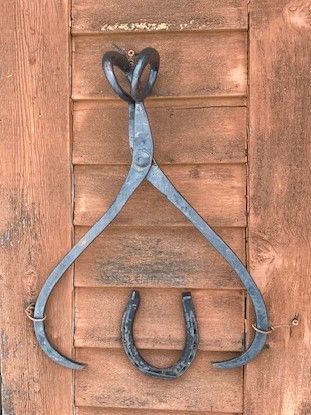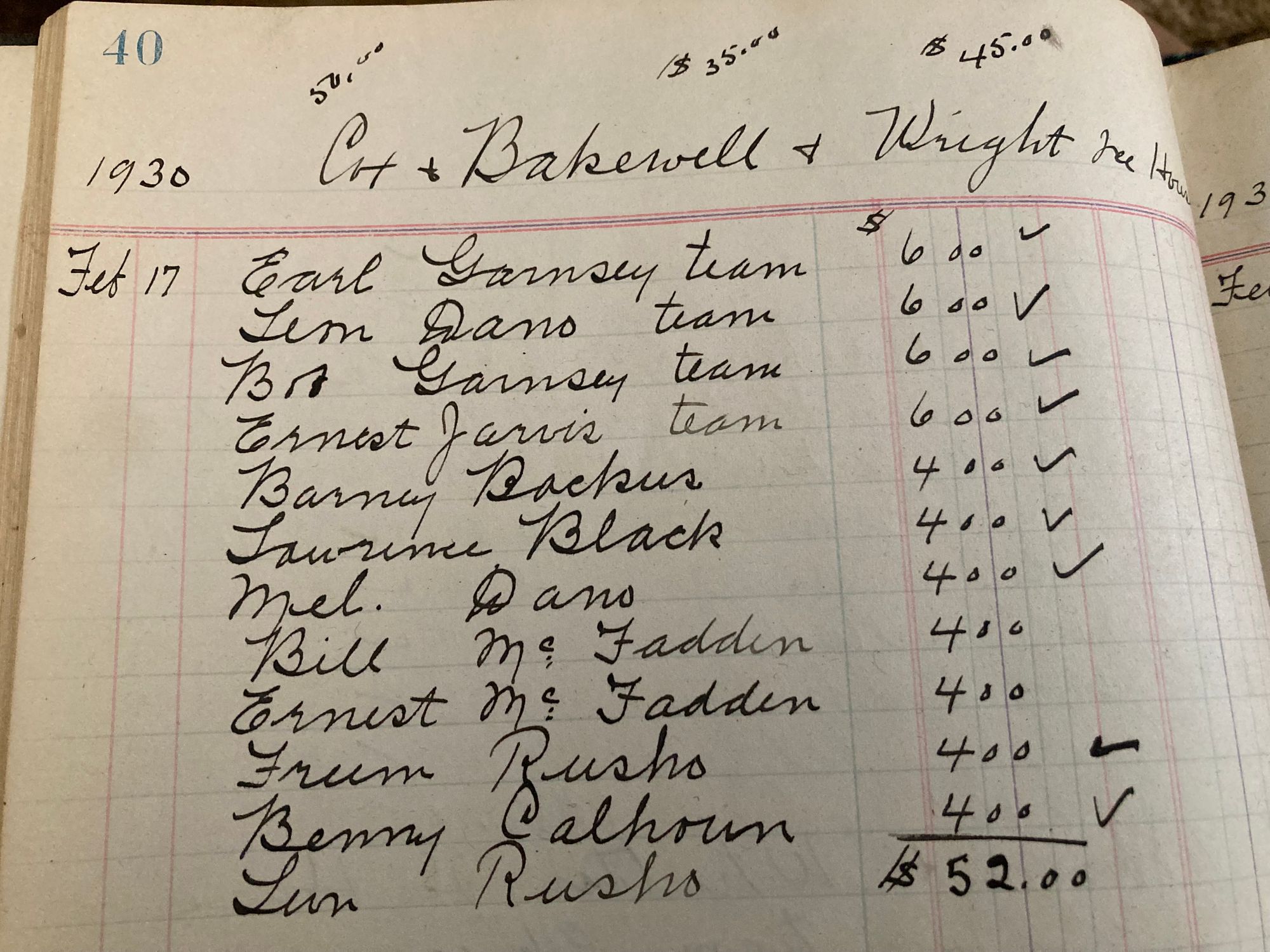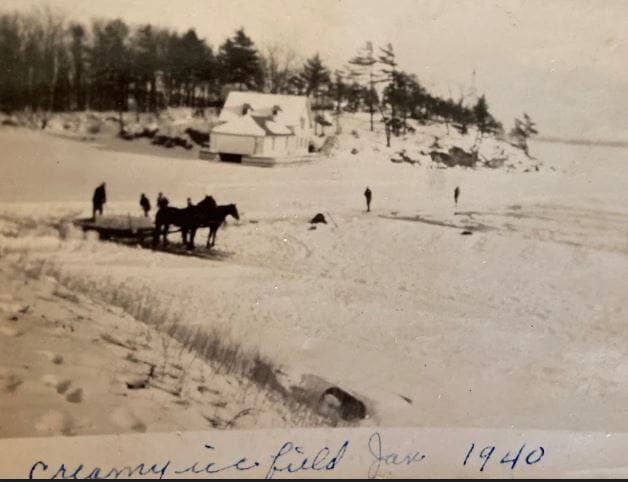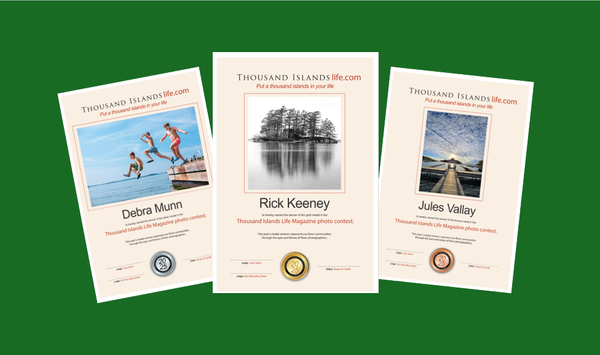The Ice Harvest
by: Manley L. Rusho
Before electric power was expanded to the Thousand Islands, there was a small, but brutal business called ice harvesting. Basically, it consisted of cutting large chunks of ice from the frozen St. Lawrence River and then transporting these chunks, or cakes, of ice to a special building called the ice house. The ice house was built for the express purpose of storing ice from the winter through the warm summer months. Ice houses were usually small, double-walled buildings, with the better ones having the inner walls filled with cork or sawdust for extra insulation. After filling the ice house with ice slabs, the top was covered with a layer of sawdust about a foot in thickness.
My grandfather, Manley A. Rusho, had developed a lucrative ice business that included retail sales and delivery. The ice house at our farm was big; it could hold perhaps 1000 ice cakes, more if the River freeze-over was mild. A mild freeze would happen if there was a heavy snow covering on the ice that prevented the cold weather from freezing down, resulting in an insulating blanket on the ice.

As a youth, my family lived about 100 yards from the icehouse my late grandfather built. It was downhill from our farmhouse and partially blocked the view of the River from our house, with only the view straight toward Clayton being unobscured. The ice house was about 60 feet long and 30 feet wide, with a height of maybe 30 or 40 feet, and a slanted roof. Remnants of white paint still clung to the sides; narrow swinging doors enclosed both ends. Each door opened out so that only a portion of the opening was exposed. On the River side of the ice house was the bottling plant where milk was bottled for delivery to the various summer homes on Grindstone Island, Bluff, Murray, Picton, and Grenell Islands, as well as Thousand Islands Park. Along with milk and ice being delivered, options included fresh eggs and vegetables, too. Some of the vegetables were from our garden, but most were from the garden of my uncle, Billy Graham, on Grindstone. Uncle Billy’s house is about half-way between the Lower Schoolhouse and the Cheese Factory. The vast garden spanned both sides of the house. The house and a group of sturdy maples still resist time and nature, and both are still standing today. The house is now empty, the once rich gardens have now gone to grass, the maples support a child’s swing.
Our ice house was located about 40 feet from the River. In front of it was a large, rounded, rock that was part of the island and which prevented access to the front of the building, so a ramp was built from the River up to the side of the building. A sled of ice cakes would pull up to the ramp, maybe ten or so cakes were loaded on to the bottom of the ramp using large ice tongs and a piece rope. The other end of the rope was hooked to a horse, which then moved off pulling the string of cakes into the building. Work never stopped until at the whole six or eight cakes were pushed into the canal still frozen together split apart with broad bladed spud bar with two men pushing the cakes on to the sled maybe 20 cakes to a load and off to the ice house.

Where and how to cut the ice? At a rather large snow drift about a half mile into the bay, the plow was unloaded and with two horses attached, two men would hold the plow at the right angle to the ice, and a driver would hold the horses. Maybe two feet of snow would be removed from the ice, followed by some quick blows with an ax through ice, and then the ax was inserted into the hole. Yes, the ice here under the snow was a good two feet thick, so the work to cut a hole would begin. The scraper cleared maybe 20 feet by 100 feet and the ice saw was unloaded. The saw was a one-horse affair with the saw and horse lined up on one side of the growing field. The horse walked in a straight line, and made the cut into the ice maybe two inches then 4 inches deep, with an attachment that was hooked to the saw. The attachment was dropped into the slot in the ice and within minutes the field was cut into blocks of ice roughly 18 inches by 3 feet.
Several passes over the field increased the saw cut into the ice by about 6 inches with each pass. At one end of the field, a canal of about 30 feet long and three feet wide was cut by hand, using an ice saw with only one handle. This canal would be used to load the sleds, with the ice cakes being pushed by hand on to a steel three-runner track. Each cake loaded by hand; it was pushed up the track by two men with pike poles. By now, the field was clear of snow, the canal was cut open, and cakes could be moved into the canal. The saw dust had been shoveled out of the ice house and the ice slides had been installed. These slides were steel bottomed with wood sides and about 4 inches high, to keep the ice cakes from falling on their way into the ice house. Now the ice house was ready to admit the cut blocks.

The thickness of the River ice was most important because a cake of ice was best at 2 feet thick, 18 inches wide, and 3 feet long. An ice cake at that perfect size weighed about 100 lbs. The only dimension that could not be changed was the thickness of the ice, which could only be controlled by nature. By the middle of February, my father began the ice harvest. The smaller ice houses that were the farthest away from us were done first. The smaller ice houses at the western-end of Grindstone, Watch Island, Chub Island, and a couple of others, could be filled in one harvest. Since these locations were close together, only one hole was cut. although two holes in one day was still easy. On paper, usually the three locations were done in two days and the equipment was then moved to the Aflack’s on Flynn Bay. Next was Boscobel Island, straight across from Aunt Jane’s Bay, where my great-uncle, David Atherton (my grandmother’s brother) worked. The Wrights and Pullins, located in Aunt Jane’s Bay, were next.
Far away to the east, at the very end of Eel Bay, is Sargent Island, which some people said was owned by Mayer of Metro-Goldwyn-Mayer Studios. I do not know if that’s true, but they paid a lot of money for our services and always paid on time. The trip there was a true sled ride over snow and ice, complete with seven horses, three sleds, and two tons of equipment, over some of the worst ice conditions. Swiftwater Channel never froze past Rusho Bay, so it was necessary to strike land somewhere near where the Smith Cottage is currently located. Continuing to pass along the channel close to Light House Island, close to Point Angiers, and on to the broad, safe, thick ice of Eel Bay, with Sargent Island only about a mile and a half away.
I remember going often with my father on these ice harvesting trips. On one such trip around 1940, in the wee hours of the morning, we were about midway to Sargent Island and we could see a light in a window of a cottage. When we arrived at almost daylight, we discovered my Uncle Benny (Calhoun) inside with a fire going in the kitchen stove. Uncle Benny and his crew of men had brought his team of horses from Grindstone, across Delaney Bay marsh to the Dano farm, across the fields to the state land, and straight across to Sargent Island, to work with us.

On this particular day, we broke for lunch inside the cottage, with the stove lit for warmth. Some of the men had brought sandwiches with them for lunch. My mother had packed a hearty beef stew in a metal creamery can, enough for all, and enough coffee for at least one cup for each man, fortified with brandy supplied by the owner of the cottage. After our break, the little warm stove was hard to leave, but we were more than half done, with another hour and a half – barring any problems – before the last of the ice would be stored for the summer.
When we had broken for lunch, so had our horses. Tied to the sleds that were piled with generous amounts of hay and oats, covered with frozen crystals of sweat and frosted breath from their nostrils. Small balls of snow and ice stuck to their feet; each horse was checked to ensure that their shoes were on tight and that all of the chocks on each shoe were tight. Water was warmed by the stove and was offered to each horse. A full-time horse shoeing kit was on my father’s sled that included extra shoes in two or three sizes, chocks, nails, pliers, hammers, and rasps. Working on ice as the horses did, their shoes had large chocks to prevent them from slipping. The shoes were nailed solidly to the hoof, each shoe had eight holes through it, and the holes were square as were the nails. They were driven into and through the hoof, coming out on the top of the hoof, and then bent over and cut off so that no sharp points could catch on anything.
By 3:00 pm, we were ready to return to Grindstone Island; all of the equipment was put back on the sleds and a lantern was lighted and placed on an ice cake by the open hole. In a couple of days, we would return to clean the cottage and retrieve the light, and secure the doors on the ice house. In mid Eel Bay, we parted company with Uncle Benny, Bob Moneau, and Uncle Benny’s dog Nero. They headed toward big hill followed by Lawrence Black and his team, including Louie Calhoun. My father, Uncle Rawdon (Dano) and myself settled down for a cool, refreshing, ride home. Back at home, the horses were released from their harnesses, put into their own stalls, wiped down with burlap bags, and given fresh hay and oats. For us, dinner was ready and Uncle Rawdon stayed to eat. As for me, by 7:00 pm, I had settled in for a good night’s sleep.
By Manley L. Rusho






Please click here if you are unable to post your comment.